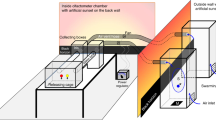Synopsis
Pair formation was studied in a polymorphic population of Gambusia holbrooki in a brackish drainage canal in Southern Florida. All females and the majority of males were gray colored and only 5% of the males were black spotted. A small fraction of the population formed pairs, composed of a female and a male that swam synchronously and close together for several minutes. During pairing the male often achieved gonopodial contact with the female. Black spotted males occurred in pairs ten fold more frequently than expected under random pairing. The major behavioral mechanism accounting for the disproportionate occurrence of spotted males in pairs is, probably, the preference of females for these males.
Similar content being viewed by others
References cited
Angus, R.A. 1989. Inheritance of melanistic pigmentation in the eastern mosquitofish. J. of Heredity 80: 387–392.
Baerends, G.P., R. Brouwer & H.T. Waterbolk. 1955. Ethological studies on Lebistes reticulatus (Peters). I. An analysis of the male courtship pattern. Behaviour 8: 249–335.
Barlow, G.W & K.R. McKaye. 1982. A comparison of feeding, spacing, and aggression in color morphs of the Midas cichlid. II. After 24 hours without food. Behavior 80: 127–142.
Barlow, G.W & P.L. Ballin. 1976. Predicting and assessing dominance from size and coloration in the polychromatic Midas cichlid. Anim. Behav. 24: 793–813.
Bisazza, A., A. Marconato & G. Marin. 1989. Male mate preferences in the mosquitofish Gambusia holbrooki. Ethology 83: 335–343.
Breden, F. & G. Stoner. 1987. Male predation risk determines female preference in the Trinidad guppy. Nature 329: 831–833.
Carlson, D.R. 1969. Female sexual receptivity in Gambusia affinis (Baired and Girard). Texas J. Sci. 21: 167–173.
Endler, J.A. 1978. A predator's view of animal color patterns. Evol. Biol. 11: 319–364.
Endler, J.A. 1980. Natural selection on color patterns in Poecilia reticulata. Evolution 34: 76–91.
Farr, J.A. 1977. Male rarity or novelty, female choice behavior and sexual selection in the guppy Poecilia reticulata Peters (Pisces: Poeciliidae). Evolution 31: 162–168.
Farr, J.A. 1980. Social behavior patterns as determinants of reproductive success in the guppy Poecilia reticulata (Pisces: Poeciliidae). An experimental study of the effects of intermale competition, female choice and sexual selection. Behavior 74: 38–91.
Fisher, R.A. 1930. The genetical theory of natural selection. The Clarendon Press, Oxford.
Greene, J.M. & K.L. Brown. 1991. Demographic and genetic characteristics of multiple inseminated female mosquitofish (Gambusia affinis). Copeia 1991: 434–444.
Hildebrand, S.F. 1927. Sex ratio in Gambusia. Biol. Bull. 53: 390–404.
Hogg, R. 1976. Ecology of fishes of the family Cichlidae introduced into the freshwaters of Dade country, Florida. M.Sc. Thesis, University of Miami, Coral Gables. 142 pp.
Houde, A.E. 1987. Mate choice based upon naturally occurring color pattern variation in a guppy population. Evolution 41: 1–10.
Kodric-Brown, A. 1989. Dietary cartenoids and male mating success in the guppy: an environmental component to female choice. Behav. Ecol. Sociobiol. 25: 393–401.
Krumholz, L.A. 1948. Reproduction in the western mosquitofish, Gambusia affinis affinis (Baird and Girard), and its use in mosquito control. Ecol. Monogr. 18: 3–43.
Loftus, W.F. & J.A. Kushlin. 1987. Freshwater fishes of Southern Florida. Fla. State Mus. Biol. Series 31 (4): 147–344.
Luyten, P.H. & N.R. Liley. 1991. Sexual selection and competitive mating success of male guppies (Poecilia reticulata) from four Trinidad populations. Behav. Ecol. Sociobiol. 28: 329–336.
Martin, R.C. 1975. Sexual and aggressive behavior, density and social structure in a natural population of mosquito fish Gambusia affinis holbrooki. Copeia 1975: 445–454.
Martin, R.C. 1977. Density dependent aggressive advantage in melanistic male mosquitofish Gambusia affinis holbrooki (Girard). Florida Sci. 40: 393–400.
Peden, A.E. 1970. Courtship behavior of Gambusia (Poeciliidae) with emphasis on isolating mechanisms. Ph.D. Dissertation, University of Texas at Austin. 273 pp.
Regan, J.D. 1961. Melanism in the poeciliid fish Gambusia affinis (Baird and Girard). Amer. Midi. Natur. 65: 139–143.
Robbins, L.W., G.D. Hartman & M.H. Smith. 1987. Dispersal, reproductive strategies, and the maintenance of genetic variability in mosquitofish (Gambusia affinis). Copeia 1987: 152–164.
Sumner, F.B. 1935. Studies on protective color change III. Experiments with fishes, both as predators and as prey. Proc. Natl. Acad. Sci. U.S.A. 21: 345–353.
Robins, C.H. 1971. Ecology of the introduced snail Marisa cornuarietis (Ampullariidae) in Dade County, Florida. The Biologist 53: 136–152.
Winge, O. 1937. Succession of broods in Lebistes. Nature 140: 467.
Webber, R., G.W. Barlow & A.H. Brush. 1973. Pigments of a color polymorphism in a cichlid fish. Comp. Biochem. Physiol. 44B: 1127–1135.
Winemiller, K.D., M. Leslie & R. Roche. 1990. Phenotypic variation in male guppies from natural inland populations: an additional test of Haskins' sexual selection/predation hypothesis. Env. Biol. Fish. 29: 179–191.
Author information
Authors and Affiliations
Rights and permissions
About this article
Cite this article
Karplus, I., Algom, D. Polymorphism and pair formation in the mosquitofish Gambusia holbrooki (Pisces: Poeciliidae). Environ Biol Fish 45, 169–176 (1996). https://doi.org/10.1007/BF00005231
Received:
Accepted:
Issue Date:
DOI: https://doi.org/10.1007/BF00005231




